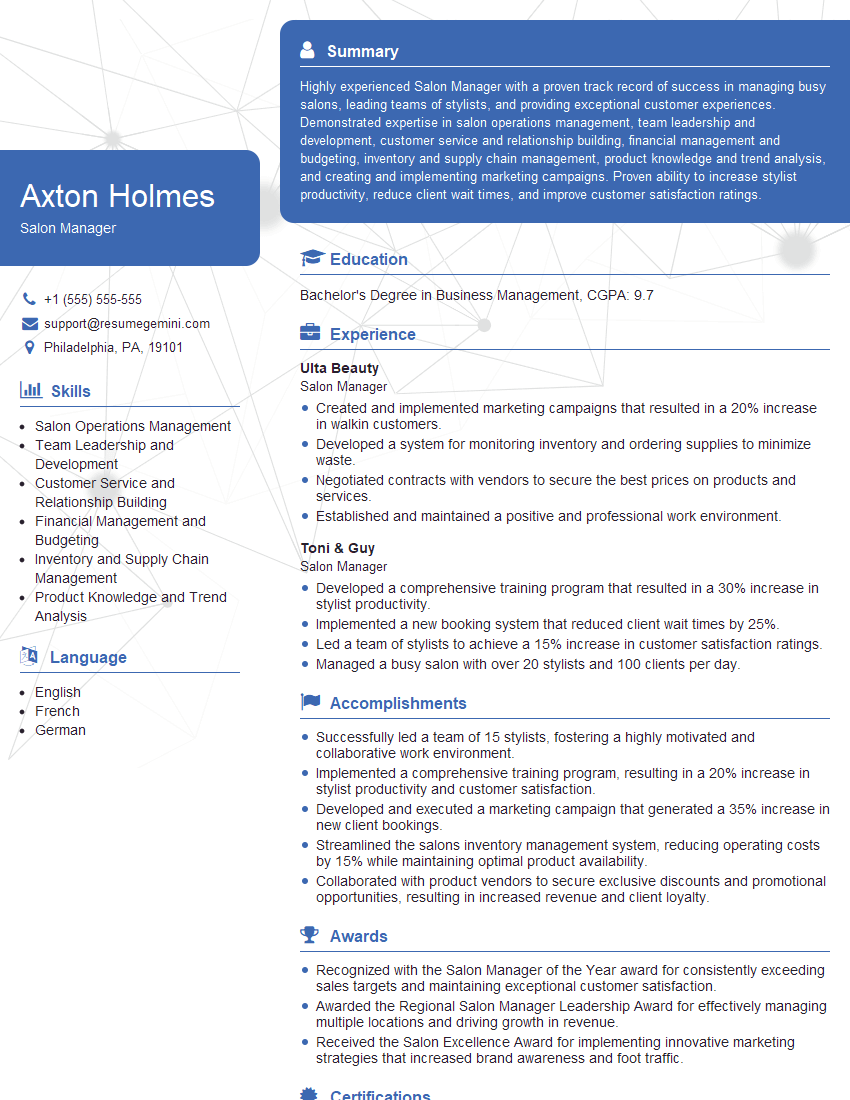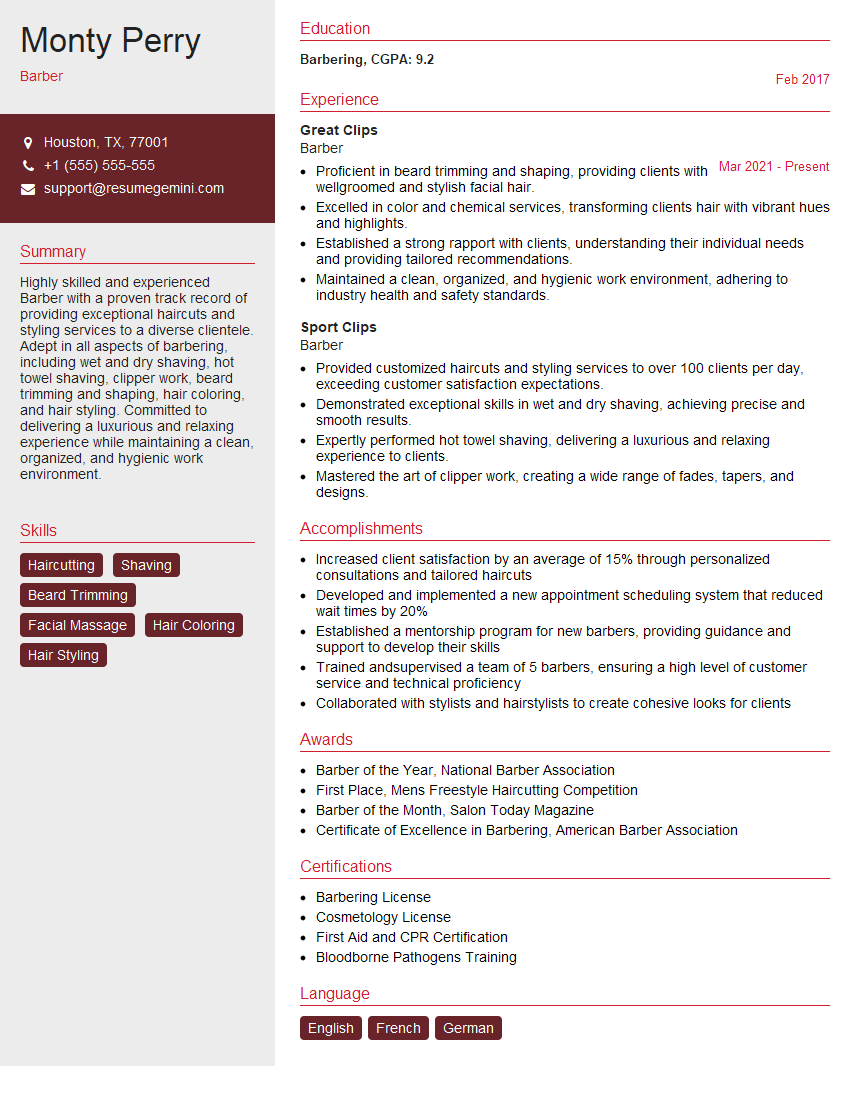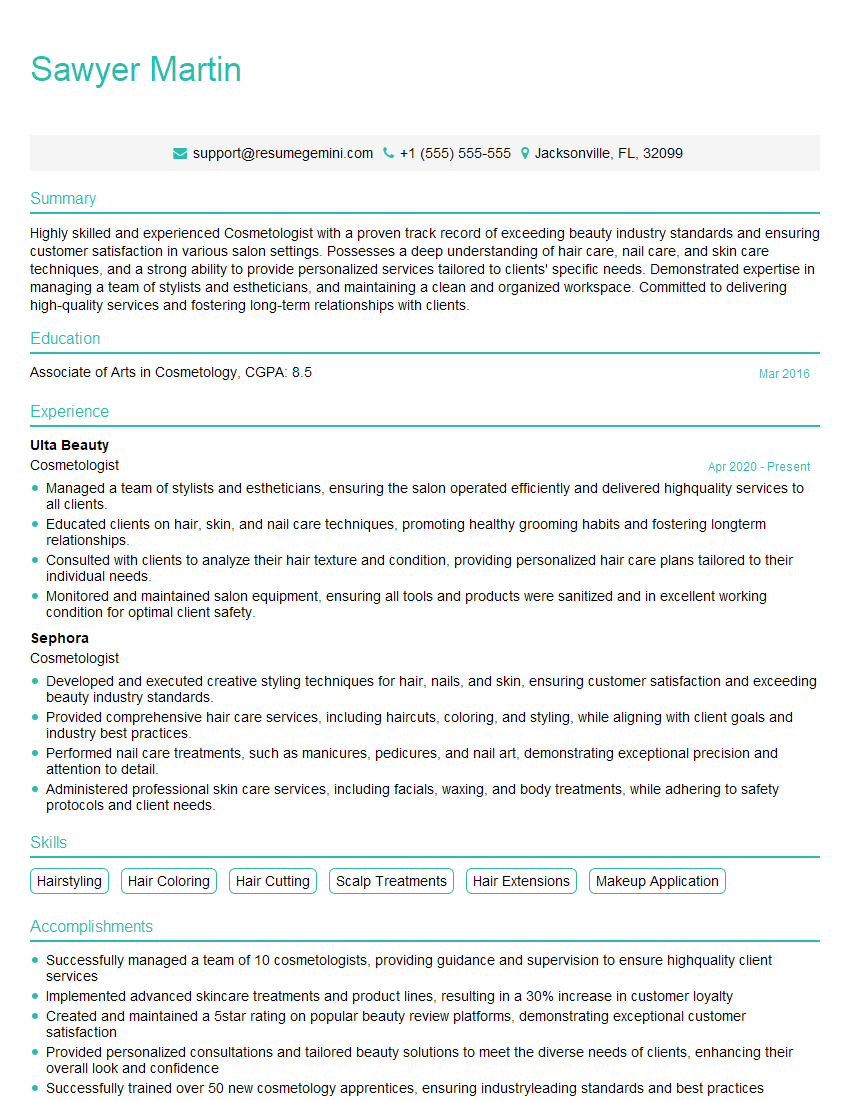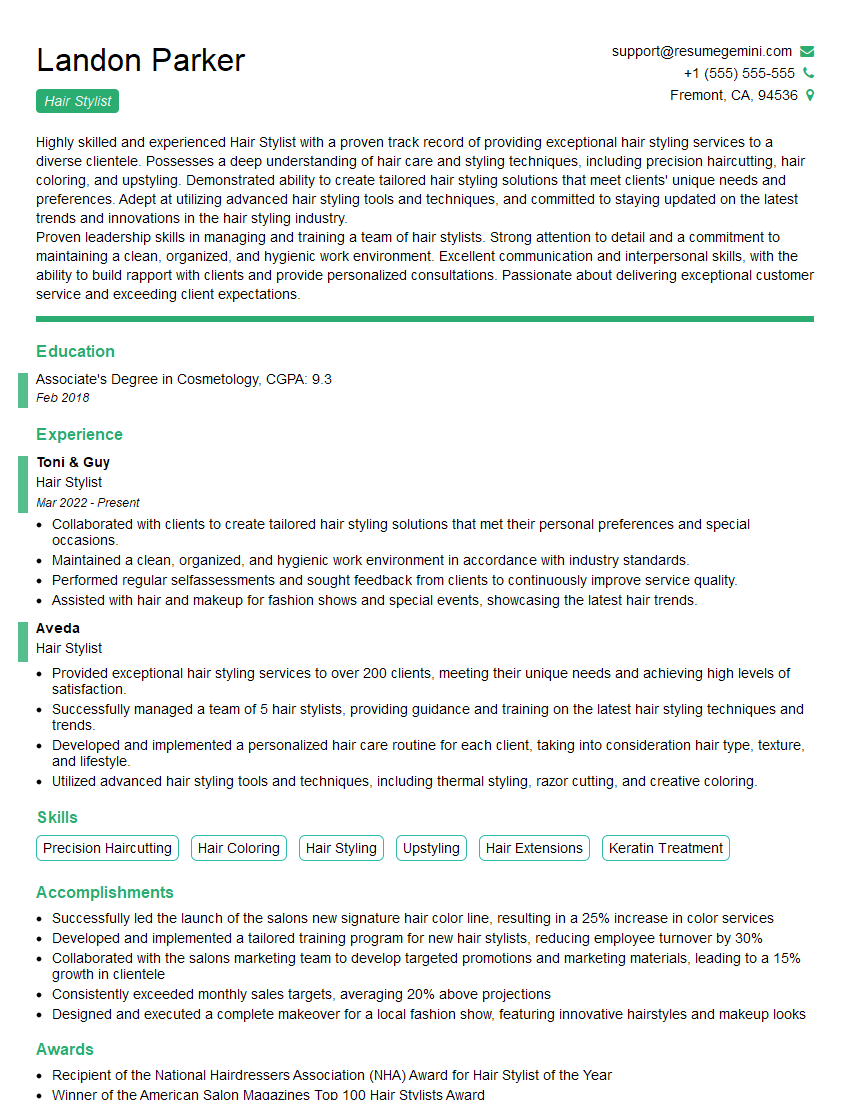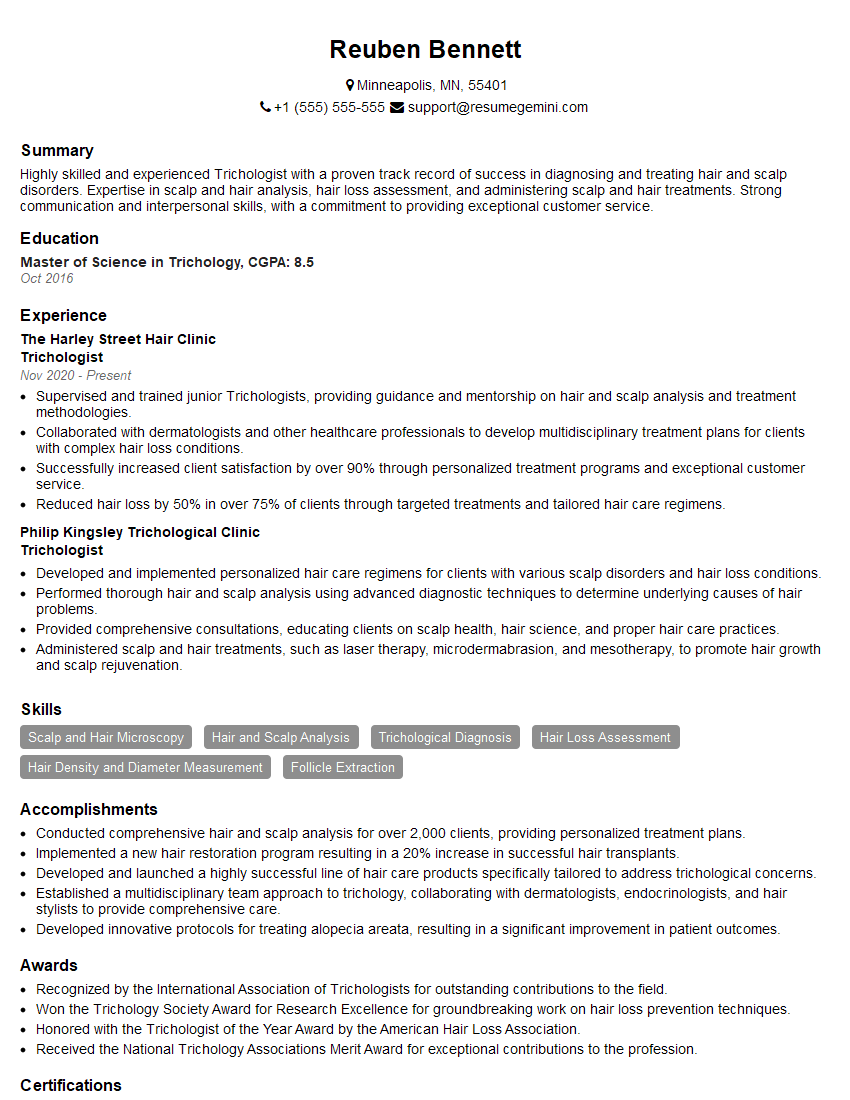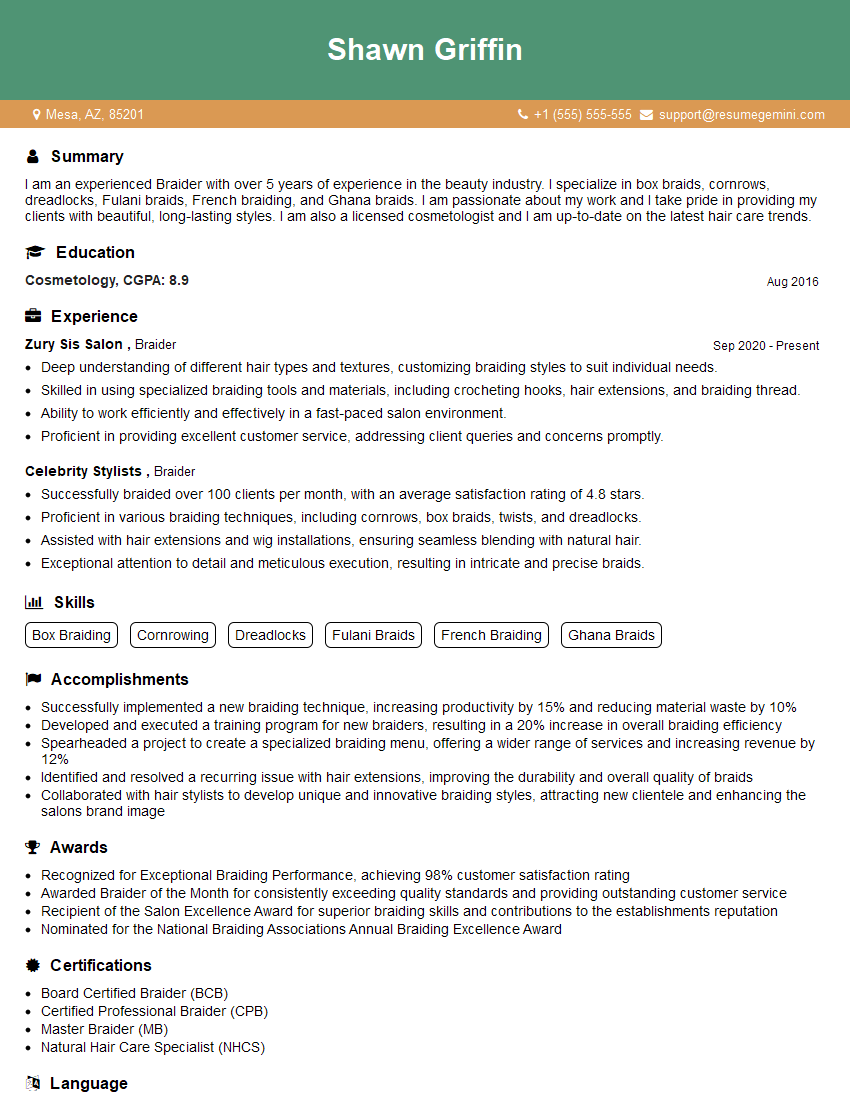Feeling uncertain about what to expect in your upcoming interview? We’ve got you covered! This blog highlights the most important Hair treatments interview questions and provides actionable advice to help you stand out as the ideal candidate. Let’s pave the way for your success.
Questions Asked in Hair treatments Interview
Q 1. Describe your experience with different hair coloring techniques.
My experience encompasses a wide range of hair coloring techniques, from classic permanent color to the latest balayage and ombre methods. I’m proficient in various application methods, including freehand painting, foiling, and highlighting. I understand the chemistry behind different color formulations, allowing me to achieve precise results and minimize damage. For example, with permanent color, I carefully assess the client’s hair condition and choose the appropriate developer strength to achieve the desired results while preserving hair health. With balayage, I focus on creating a natural-looking sun-kissed effect by carefully painting highlights onto the hair, customizing the placement and intensity based on the client’s features and preferences. I also have extensive experience with color correction, addressing issues such as unwanted tones or uneven color distribution. This requires a deep understanding of color theory and a strategic approach to gradually correct the color without further damaging the hair.
- Permanent Color: Provides lasting color change, covering gray hairs effectively.
- Demi-Permanent Color: Offers subtle color changes and shine enhancement, with less commitment.
- Semi-Permanent Color: Adds temporary color or tone, gradually fading with washes.
- Balayage: A freehand painting technique creating a natural-looking, sun-kissed effect.
- Ombre: A gradual transition between two different hair colors.
Q 2. What are the different types of hair extensions and their application methods?
Hair extensions offer a fantastic way to add length, volume, or texture. The choice depends on the client’s hair type, budget, and desired outcome. Application methods also vary widely.
- Clip-in Extensions: These are the easiest to apply and remove, perfect for temporary use. Simply clip them onto your natural hair.
- Tape-in Extensions: Thin wefts of hair are attached using medical-grade adhesive tape, offering a seamless and relatively long-lasting result.
- Sew-in Weave Extensions: These are sewn onto cornrows or braids, offering a secure and long-lasting application, ideal for longer wear. Maintenance requires regular tightening and adjustments.
- Fusion/Keratin Bond Extensions: Individual strands of hair are attached using a small amount of keratin bond, melted with heat. They’re versatile but require specialized tools and skill to apply and remove safely.
- Micro-ring Extensions: Small metal rings are used to secure the extensions to natural hair. These are generally less damaging than fusion bonds.
Each application method requires specific skills and tools. For instance, fusion bonds demand precise application to avoid damaging the natural hair. Sew-in weaves require expertise in braiding and sewing techniques to achieve a secure and comfortable fit. Choosing the right method is crucial for both aesthetics and the health of the client’s hair.
Q 3. Explain the process of assessing hair damage and recommending appropriate treatments.
Assessing hair damage is a crucial first step in any treatment plan. I begin by visually inspecting the hair for signs of breakage, split ends, dryness, or discoloration. Then, I run my fingers through the hair to assess its texture and elasticity. A thorough consultation with the client is essential to understand their hair care routine, styling habits, and any past treatments.
Tools such as a hair porosity test can help to determine how well the hair shaft absorbs moisture, and I may also use a strand test to check the strength and elasticity of the hair. Based on my assessment, I determine the level of damage and recommend appropriate treatments.
For example, mildly damaged hair might respond well to deep conditioning treatments and regular trims, while severely damaged hair might require more intensive treatments like protein treatments or even reconstructive masks. I always prioritize minimizing further damage and restoring the hair’s health and shine. I would explain the proposed treatment plan, its benefits, and potential risks to the client and discuss realistic expectations.
Q 4. How do you handle challenging client requests or situations?
Handling challenging client requests or situations requires diplomacy, empathy, and problem-solving skills. I always start by actively listening to the client’s concerns and trying to understand their perspective. Even if I don’t agree with their request, I try to find common ground. For example, if a client wants a drastic color change that might damage their hair, I’ll explain the potential risks and suggest alternative options that achieve a similar look with less damage. If a client is unhappy with a service, I apologize for any inconvenience and try to find a solution that satisfies them, whether it’s a re-do or a partial refund. I believe in open communication and transparency to build trust and resolve any issues amicably. Documentation of the process and client’s feedback helps in these situations.
Q 5. What are your preferred methods for creating specific hairstyles (e.g., updos, braids)?
My preferred methods for creating hairstyles are based on years of practice and a strong foundation in classic techniques. For updos, I favor techniques that are both elegant and practical, ensuring the style lasts throughout the day. I incorporate various braiding techniques, twists, and pinning methods to create unique and personalized looks. I often begin by analyzing the client’s hair texture, length, and desired style to create a tailored approach. For example, a client with thick, long hair might be suited to a voluminous French twist, while a client with fine hair might benefit from a more intricate braided updo to add texture and volume.
Braiding is another area of expertise. I’m proficient in various braiding techniques, including French braids, fishtail braids, Dutch braids, and more intricate patterns. The choice of braiding method depends on the client’s hair type, length, and desired look. I adapt techniques to create both classic and modern braided styles. A visual consultation is usually helpful to ensure I understand the client’s vision.
Q 6. How do you maintain hygiene and sanitation standards in a salon environment?
Maintaining hygiene and sanitation standards is paramount in a salon environment. I follow strict protocols to ensure the safety and well-being of clients and myself. This includes sterilizing all tools and equipment, using disposable capes and towels, and thoroughly cleaning workspaces between clients. I regularly wash my hands, use sanitized combs and brushes, and follow all recommended guidelines for handling chemicals and disposing of waste materials appropriately. We adhere to state-mandated sanitation guidelines and regularly undergo internal training to maintain our expertise in best practices. Cleanliness is not just about appearance; it’s fundamental to prevent the spread of infections and ensures a safe and comfortable environment for everyone. Clients often appreciate seeing this in practice and it reinforces their trust.
Q 7. Describe your experience with various hair cutting techniques (e.g., layering, blunt cuts).
My hair cutting techniques are versatile and tailored to each client’s individual needs and preferences. I’m adept at various cutting methods, including layering, blunt cuts, texturizing, and point cutting. Layering can add volume and movement to fine hair, while blunt cuts create a bold and sleek look for thicker hair. Texturizing techniques, such as point cutting, are used to remove bulk and add texture, creating a more natural and lived-in look. I also use specific cutting techniques depending on the hair type and desired style. For example, when cutting curly hair, I avoid over-cutting to maintain its shape and volume. I find using a combination of methods often yields the most stylish and flattering results. This holistic approach ensures the final look is both aesthetically pleasing and easy for clients to style at home.
Q 8. How do you manage your time effectively when working with multiple clients?
Effective time management is crucial in my profession. I use a combination of strategies. Firstly, I meticulously schedule appointments, allocating sufficient time for each client’s needs, considering the complexity of the service requested. Secondly, I prioritize tasks – urgent requests take precedence, while others are planned strategically throughout the day. Thirdly, I utilize digital tools like scheduling software and client management systems to track appointments, reminders, and product inventory. This prevents double-booking and ensures smooth workflow. Lastly, maintaining a clean and organized workspace helps reduce time wasted searching for tools or products. Imagine it like conducting an orchestra – each musician (client) has their designated time slot, and efficient preparation is key to a harmonious performance.
Q 9. What are the common causes of hair loss and how do you advise clients?
Hair loss has many causes. Common ones include hereditary factors (androgenetic alopecia, the most frequent type), hormonal imbalances (like thyroid issues or post-pregnancy changes), nutritional deficiencies (iron, zinc, protein), stress, medical conditions (autoimmune diseases, certain cancers), and scalp infections. I always advise clients to consult their doctor to rule out underlying medical problems. Once those are excluded, we can discuss potential solutions. These might include lifestyle changes (improved diet, stress management), topical treatments (minoxidil), or hair loss therapies like platelet-rich plasma (PRP) injections. For example, a client experiencing hair thinning post-pregnancy might benefit from a nutritional plan alongside stress-reducing techniques and possibly a volumizing hair treatment.
Q 10. Explain your knowledge of different hair types and textures (e.g., fine, thick, curly, straight).
Understanding hair types and textures is fundamental. Hair can be categorized by thickness (fine, medium, thick), density (number of hairs per square inch), and texture (straight, wavy, curly, coily). Fine hair is delicate, prone to breakage; thick hair is strong and resilient; curly hair is prone to dryness; straight hair is typically less prone to damage. For instance, a client with fine, straight hair requires gentle styling techniques and products to avoid breakage, whereas someone with thick, curly hair needs moisturizing treatments to manage dryness and frizz. Each hair type has unique needs, and I tailor my recommendations accordingly, focusing on products and styling techniques that support the hair’s natural structure and health.
Q 11. How do you consult with clients to determine their hair goals and needs?
Client consultation is a crucial step. I begin by engaging in open communication, discussing their hair history (past treatments, products used), present concerns (hair loss, dryness, damage), and their desired look. I observe their hair texture, density, and condition, assessing any underlying issues. Then, I present options that align with their goals and hair type, realistically addressing any limitations. For example, if a client with fine hair wants long, voluminous hair, I will suggest gentle volumizing products and styling techniques, instead of promising an impossible outcome. It’s about setting realistic expectations and offering tailored solutions.
Q 12. What are the safety precautions associated with chemical hair treatments (e.g., perms, relaxers)?
Chemical treatments like perms and relaxers involve strong chemicals that can damage hair if not handled properly. Safety precautions include: always performing a strand test to check for allergic reactions or damage; following product instructions meticulously; using appropriate protective gear (gloves, eye protection); and ensuring proper ventilation. I also emphasize the importance of aftercare – using moisturizing conditioners and minimizing heat styling to help repair any potential damage. Ignoring safety protocols can lead to scalp burns, allergic reactions, and severe hair damage. Client education is critical in minimizing risks.
Q 13. How do you stay updated with the latest trends and techniques in hair styling?
Staying updated is key to my profession. I regularly attend industry events, workshops, and seminars. I subscribe to professional hairdressing magazines and online resources, following leading stylists and brands on social media. I also continuously test and experiment with new products and techniques to evaluate their effectiveness and suitability for different hair types. Continuous learning ensures I can offer clients the most current and effective services. For example, staying abreast of new keratin treatments or hair coloring techniques allows me to offer my clients the most innovative and effective solutions.
Q 14. Describe your experience with using different hair products and their benefits.
My experience with hair products is extensive. I have worked with various brands and types – from moisturizing shampoos and conditioners for dry, damaged hair, to volumizing mousses for fine hair, and styling gels for curly hair. I consider factors like ingredients (natural vs. chemical), pH balance, and intended purpose when choosing a product. For example, sulfate-free shampoos are gentler on hair; protein-based conditioners help repair damage; and leave-in conditioners provide added moisture and protection. I always explain the benefits of each product to my clients, emphasizing how it addresses their specific concerns and hair type.
Q 15. How do you handle client complaints or dissatisfaction?
Handling client complaints is crucial for building trust and maintaining a positive reputation. My approach is always centered around empathy and finding solutions. First, I actively listen to the client’s concerns without interruption, validating their feelings. Then, I ask clarifying questions to fully understand the issue. For example, if a client is unhappy with a haircut, I’d ask about specific aspects they dislike – length, shape, texture. This helps pinpoint the problem. Next, I propose solutions. This could involve a minor adjustment to the style, a complimentary treatment, or even a complete redo, depending on the situation. I always aim to exceed expectations to turn a negative experience into a positive one. Finally, I follow up to ensure the client is satisfied and address any lingering concerns. Documentation of the complaint and resolution is essential for professional record-keeping.
Career Expert Tips:
- Ace those interviews! Prepare effectively by reviewing the Top 50 Most Common Interview Questions on ResumeGemini.
- Navigate your job search with confidence! Explore a wide range of Career Tips on ResumeGemini. Learn about common challenges and recommendations to overcome them.
- Craft the perfect resume! Master the Art of Resume Writing with ResumeGemini’s guide. Showcase your unique qualifications and achievements effectively.
- Don’t miss out on holiday savings! Build your dream resume with ResumeGemini’s ATS optimized templates.
Q 16. What are your strengths and weaknesses as a hair stylist?
One of my greatest strengths is my adaptability. I’m comfortable working with various hair types and textures, and I can quickly adjust my techniques to meet individual client needs. For instance, I recently adapted a balayage technique for a client with extremely fine hair, achieving a subtle, natural-looking highlight without causing damage. I also pride myself on my strong communication skills – I believe a clear and open dialogue is essential for a successful outcome. A weakness I’m actively working on is time management, especially when dealing with complex styles that require meticulous attention to detail. I’m improving this by using scheduling apps and breaking down complex tasks into smaller, manageable steps.
Q 17. Describe your experience with scalp analysis and treatment.
Scalp analysis is a cornerstone of my practice. I begin by visually examining the scalp for signs of dryness, oiliness, inflammation, or other irregularities. I then use a magnifying tool to assess the hair follicles and look for signs of dandruff, psoriasis, or other scalp conditions. I also feel the scalp to assess its texture and temperature. Based on this assessment, I can determine the appropriate treatment plan. For example, a client with a dry, flaky scalp might benefit from a hydrating scalp treatment and a gentle clarifying shampoo. For someone with oily hair and an inflamed scalp, I might recommend a medicated shampoo and a balancing scalp treatment. I keep detailed records of each scalp analysis, making it easier to track progress and tailor future treatments.
Q 18. Explain your understanding of hair growth cycles.
Understanding the hair growth cycle is fundamental to effective hair care. Hair growth occurs in three phases: anagen (growth), catagen (transition), and telogen (resting). During the anagen phase, which can last from two to seven years, hair grows actively. The catagen phase is a short transitional period, and the telogen phase lasts around three months, after which the hair sheds and a new hair begins the cycle. Different factors like genetics, hormonal changes, and stress can influence these phases. For instance, chronic stress can prolong the telogen phase leading to increased hair shedding. Knowing these cycles helps me advise clients on realistic expectations about hair growth and address issues like hair loss appropriately. Understanding the growth cycle allows me to suggest treatments that target each phase, promoting healthier and faster growth, such as stimulating treatments in the anagen phase.
Q 19. How do you address specific hair concerns (e.g., dandruff, split ends, dryness)?
Addressing specific hair concerns requires a tailored approach. For dandruff, I recommend medicated shampoos containing ingredients like selenium sulfide or zinc pyrithione, along with regular scalp exfoliation. For split ends, trimming is the only effective solution; I also advise clients on minimizing damage through protective styling and regular conditioning. Dryness is often addressed through deep conditioning treatments, hydrating shampoos and conditioners, and avoiding harsh heat styling. In all cases, I educate the client on the underlying cause of the problem and provide preventative strategies to avoid recurrence. For example, if a client has dry hair due to sun exposure, I might recommend using a leave-in conditioner with UV protection.
Q 20. What is your experience with different hair styling tools (e.g., flat irons, curling irons)?
I’m proficient in using various styling tools, always prioritizing the client’s hair health. I use flat irons for straightening, ensuring the temperature is appropriate for the hair type and using a heat protectant spray. With curling irons, I focus on proper technique to avoid heat damage and create lasting curls. I regularly maintain and clean my tools to ensure their longevity and hygienic use. I understand that overuse of heat styling tools can damage the hair, so I always recommend alternative styling methods when possible, like air drying or using rollers.
Q 21. How do you communicate effectively with clients to understand their needs and preferences?
Effective communication is key to my success. I begin by conducting a thorough consultation, asking questions about the client’s lifestyle, hair history, and desired style. I actively listen, paying attention not only to what they say but also to their body language. I use visual aids like magazines and photos to help clients communicate their preferences more effectively. I also explain the process and any potential limitations realistically, ensuring they understand what’s possible and what’s not. I encourage questions throughout the process and always confirm their satisfaction before finishing. For example, if a client wants a particular color, I’ll show them swatches and discuss whether their hair’s current condition will allow for achieving the desired result.
Q 22. Explain your experience with working with different hair textures.
My experience spans a wide range of hair textures, from fine and straight to thick and coily. I understand that each texture has unique needs and responds differently to treatments. For example, fine hair requires gentler products and techniques to avoid breakage, while coily hair needs moisture-rich products and careful detangling to prevent damage. I’ve worked extensively with various ethnicities and hair types, adapting my approach to achieve the best results for each individual. I tailor my consultations to understand a client’s hair history, lifestyle, and desired outcome before selecting the appropriate products and techniques. This individualized approach ensures I address concerns such as dryness, frizz, breakage, and lack of volume effectively.
- Fine Hair: I use lightweight products and avoid harsh chemicals to prevent damage and maintain volume.
- Thick Hair: I utilize deep conditioning treatments and detangling techniques to manage thickness and prevent breakage.
- Coily Hair: I specialize in techniques that minimize manipulation to preserve curl definition and prevent damage while adding hydration.
Q 23. How do you ensure client satisfaction?
Client satisfaction is paramount. I achieve this through a multi-pronged approach: Firstly, I prioritize clear and open communication. I listen attentively to my clients’ concerns and expectations, asking clarifying questions to ensure complete understanding. Secondly, I provide a personalized consultation, analyzing their hair type, condition, and lifestyle to recommend the most suitable treatment plan. Thirdly, I strive to exceed expectations by meticulously performing the service, paying attention to detail and ensuring a comfortable experience. Finally, I actively seek feedback and address any concerns promptly. I follow up after the appointment to answer any lingering questions or concerns. For example, if a client isn’t completely satisfied with a color treatment, I offer a complimentary adjustment to meet their expectations.
Q 24. Describe your knowledge of different hair care products.
My knowledge of hair care products is extensive. I’m familiar with various brands and formulations, understanding their ingredients, benefits, and potential side effects. This includes shampoos, conditioners, styling products, chemical treatments (like relaxers, perms, and color), and deep conditioners. I know how to select products tailored to specific hair types and concerns, considering factors like porosity, elasticity, and scalp health. For instance, I know that a client with high porosity hair needs products that lock in moisture, while someone with low porosity hair needs products that penetrate easily. I also stay updated on the latest industry trends and innovations in hair care technology.
- Shampoos: I understand the differences between clarifying, moisturizing, and volumizing shampoos and how to select the right one for different needs.
- Conditioners: I know the importance of deep conditioning treatments for damaged or dry hair, and I can recommend suitable products based on the hair’s porosity and needs.
- Chemical Treatments: I have thorough knowledge of the application and safety procedures for relaxers, perms, and hair color, including managing the risks associated with chemical sensitivities.
Q 25. How do you handle difficult clients?
Handling difficult clients requires patience, empathy, and strong communication skills. My approach begins with active listening – understanding their concerns, even if expressed negatively. I validate their feelings and try to find common ground. If a misunderstanding arises, I calmly explain the situation, offering different perspectives or solutions. I never argue or become defensive. For example, if a client is unhappy with a service, I offer a sincere apology and explain the steps I’ll take to rectify the situation. If necessary, I involve a manager to mediate the situation. Ultimately, I aim to de-escalate the situation and find a solution that satisfies the client and maintains professionalism.
Q 26. What is your approach to managing work stress in a busy salon environment?
Managing stress in a busy salon environment is crucial. My strategies include effective time management, prioritizing tasks, and maintaining a positive attitude. I use techniques such as deep breathing exercises or short meditation breaks to stay calm under pressure. I also prioritize breaks throughout the day to avoid burnout. Maintaining a strong support system with colleagues is key, allowing me to share workloads or concerns as needed. Setting realistic expectations and avoiding overbooking helps prevent feeling overwhelmed. Finally, practicing self-care outside of work, such as exercise and hobbies, helps manage overall stress levels.
Q 27. How do you prioritize tasks when working with multiple clients?
Prioritizing tasks with multiple clients involves efficient scheduling and clear communication. I use a combination of appointment scheduling software and visual aids (like a schedule board) to track appointments and services. I group similar tasks together to optimize workflow. For example, I might perform all shampoos for several clients at once before proceeding with other treatments. I communicate clearly with clients about anticipated wait times and manage expectations. Time management and prioritization skills, combined with effective communication, allow me to work efficiently and keep clients happy.
Q 28. Describe your experience with hair braiding techniques.
I possess extensive experience in various hair braiding techniques, including cornrows, box braids, and other protective styles. My expertise extends to understanding hair health within these techniques, ensuring minimal tension to prevent traction alopecia. I adapt my braiding techniques to different hair textures and lengths, considering factors like density and curl pattern. I am proficient in creating intricate braid patterns and can customize designs to fit individual preferences. For instance, I can add extensions for added length or volume and incorporate beads or other decorative elements. Safety and client comfort are always prioritized, ensuring that braiding techniques are executed carefully and without causing discomfort.
Key Topics to Learn for Hair Treatments Interview
- Hair Anatomy and Physiology: Understanding hair structure (cuticle, cortex, medulla), growth cycle, and common hair types (fine, medium, coarse; straight, wavy, curly, coily).
- Hair Chemistry: Knowledge of chemical processes involved in various treatments like perms, relaxers, and color applications. Understanding pH levels and their impact on hair health.
- Common Hair Treatments: Practical application of techniques such as cutting, styling, coloring (including highlighting and balayage), perming, relaxing, and deep conditioning treatments. This includes understanding different product types and their application.
- Client Consultation & Assessment: Mastering the art of effective client communication to understand their needs and hair history. Accurately assessing hair condition to recommend appropriate treatments.
- Hair Health & Scalp Conditions: Identifying and addressing common scalp issues (dandruff, psoriasis, etc.) and recommending appropriate solutions. Understanding the impact of lifestyle factors on hair health.
- Safety and Hygiene Protocols: Demonstrating a strong understanding of salon safety regulations, sanitation practices, and the proper handling of chemicals and tools.
- Problem-Solving & Troubleshooting: Developing the ability to diagnose and rectify common issues encountered during hair treatments, such as uneven color application, damaged hair, or allergic reactions.
- Trends & Innovations: Staying updated on the latest trends in hair styling, coloring techniques, and product innovations within the industry.
Next Steps
Mastering hair treatments opens doors to exciting career opportunities and allows you to build a successful and fulfilling career in the beauty industry. To increase your chances of landing your dream job, creating a strong, ATS-friendly resume is crucial. ResumeGemini is a trusted resource that can help you craft a professional and impactful resume that highlights your skills and experience effectively. ResumeGemini provides examples of resumes tailored specifically to the hair treatments field, ensuring your application stands out. Take the next step towards your dream job – build your best resume with ResumeGemini.
Explore more articles
Users Rating of Our Blogs
Share Your Experience
We value your feedback! Please rate our content and share your thoughts (optional).
What Readers Say About Our Blog
Hello,
We found issues with your domain’s email setup that may be sending your messages to spam or blocking them completely. InboxShield Mini shows you how to fix it in minutes — no tech skills required.
Scan your domain now for details: https://inboxshield-mini.com/
— Adam @ InboxShield Mini
Reply STOP to unsubscribe
Hi, are you owner of interviewgemini.com? What if I told you I could help you find extra time in your schedule, reconnect with leads you didn’t even realize you missed, and bring in more “I want to work with you” conversations, without increasing your ad spend or hiring a full-time employee?
All with a flexible, budget-friendly service that could easily pay for itself. Sounds good?
Would it be nice to jump on a quick 10-minute call so I can show you exactly how we make this work?
Best,
Hapei
Marketing Director
Hey, I know you’re the owner of interviewgemini.com. I’ll be quick.
Fundraising for your business is tough and time-consuming. We make it easier by guaranteeing two private investor meetings each month, for six months. No demos, no pitch events – just direct introductions to active investors matched to your startup.
If youR17;re raising, this could help you build real momentum. Want me to send more info?
Hi, I represent an SEO company that specialises in getting you AI citations and higher rankings on Google. I’d like to offer you a 100% free SEO audit for your website. Would you be interested?
Hi, I represent an SEO company that specialises in getting you AI citations and higher rankings on Google. I’d like to offer you a 100% free SEO audit for your website. Would you be interested?
good
